wheel torque Seat Ibiza 5D 2011 Owner's manual
[x] Cancel search | Manufacturer: SEAT, Model Year: 2011, Model line: Ibiza 5D, Model: Seat Ibiza 5D 2011Pages: 278, PDF Size: 3.83 MB
Page 166 of 278
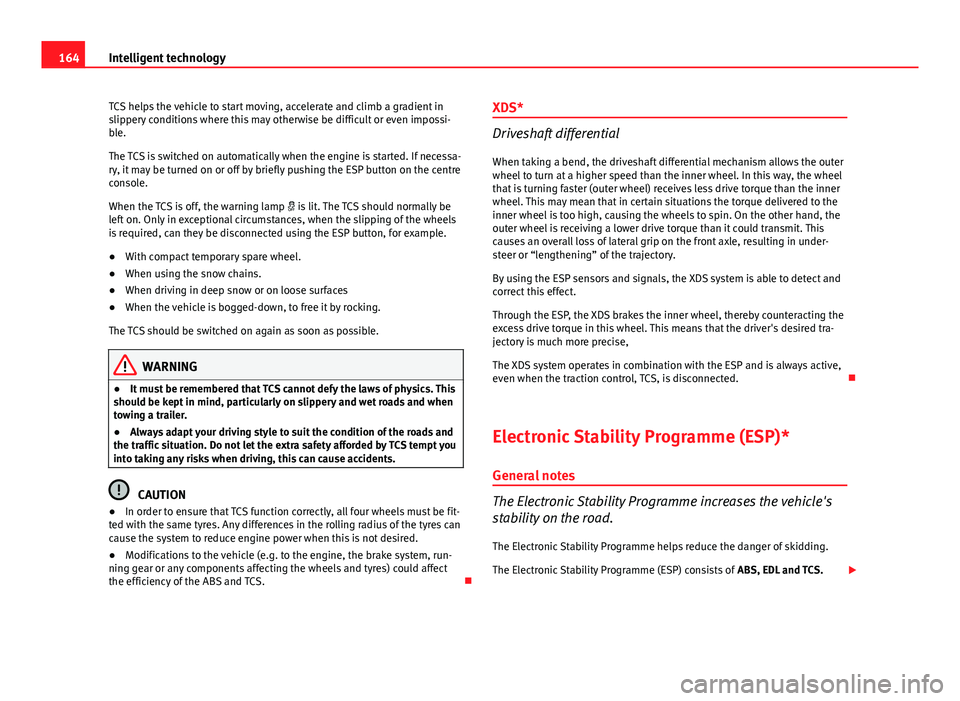
164Intelligent technology
TCS helps the vehicle to start moving, accelerate and climb a gradient in
slippery conditions where this may otherwise be difficult or even impossi-
ble.
The TCS is switched on automatically when the engine is started. If necessa-
ry, it may be turned on or off by briefly pushing the ESP button on the centre
console.
When the TCS is off, the warning lamp is lit. The TCS should normally be
left on. Only in exceptional circumstances, when the slipping of the wheels
is required, can they be disconnected using the ESP button, for example.
● With compact temporary spare wheel.
● When using the snow chains.
● When driving in deep snow or on loose surfaces
● When the vehicle is bogged-down, to free it by rocking.
The TCS should be switched on again as soon as possible.
WARNING
● It must be remembered that TCS cannot defy the laws of physics. This
should be kept in mind, particularly on slippery and wet roads and when
towing a trailer.
● Always adapt your driving style to suit the condition of the roads and
the traffic situation. Do not let the extra safety afforded by TCS tempt you
into taking any risks when driving, this can cause accidents.
CAUTION
● In order to ensure that TCS function correctly, all four wheels must be fit-
ted with the same tyres. Any differences in the rolling radius of the tyres can
cause the system to reduce engine power when this is not desired.
● Modifications to the vehicle (e.g. to the engine, the brake system, run-
ning gear or any components affecting the wheels and tyres) could affect
the efficiency of the ABS and TCS. XDS*
Driveshaft differential
When taking a bend, the driveshaft differential mechanism allows the outer
wheel to turn at a higher speed than the inner wheel. In this way, the wheel
that is turning faster (outer wheel) receives less drive torque than the inner
wheel. This may mean that in certain situations the torque delivered to the
inner wheel is too high, causing the wheels to spin. On the other hand, the
outer wheel is receiving a lower drive torque than it could transmit. This
causes an overall loss of lateral grip on the front axle, resulting in under-
steer or “lengthening” of the trajectory.
By using the ESP sensors and signals, the XDS system is able to detect and
correct this effect.
Through the ESP, the XDS brakes the inner wheel, thereby counteracting the
excess drive torque in this wheel. This means that the driver's desired tra-
jectory is much more precise,
The XDS system operates in combination with the ESP and is always active,
even when the traction control, TCS, is disconnected.
Electronic Stability Programme (ESP)* General notes
The Electronic Stability Programme increases the vehicle's
stability on the road.
The Electronic Stability Programme helps reduce the danger of skidding.
The Electronic Stability Programme (ESP) consists of ABS, EDL and TCS.
Page 216 of 278
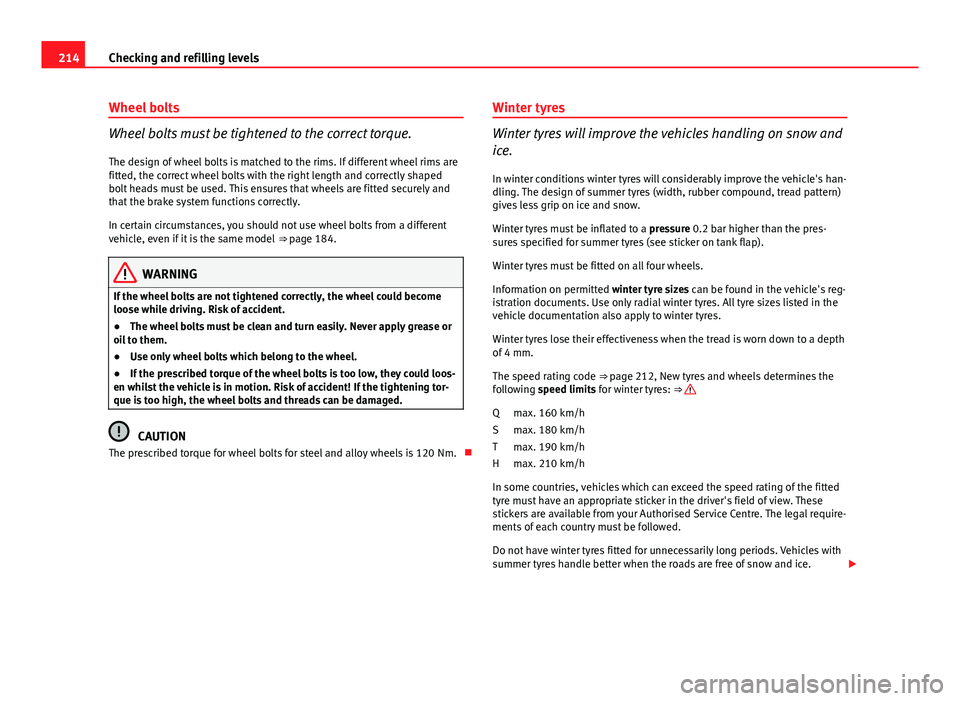
214Checking and refilling levels
Wheel bolts
Wheel bolts must be tightened to the correct torque.
The design of wheel bolts is matched to the rims. If different wheel rims are
fitted, the correct wheel bolts with the right length and correctly shaped
bolt heads must be used. This ensures that wheels are fitted securely and
that the brake system functions correctly.
In certain circumstances, you should not use wheel bolts from a different
vehicle, even if it is the same model ⇒ page 184.
WARNING
If the wheel bolts are not tightened correctly, the wheel could become
loose while driving. Risk of accident.
● The wheel bolts must be clean and turn easily. Never apply grease or
oil to them.
● Use only wheel bolts which belong to the wheel.
● If the prescribed torque of the wheel bolts is too low, they could loos-
en whilst the vehicle is in motion. Risk of accident! If the tightening tor-
que is too high, the wheel bolts and threads can be damaged.
CAUTION
The prescribed torque for wheel bolts for steel and alloy wheels is 120 Nm. Winter tyres
Winter tyres will improve the vehicles handling on snow and
ice.
In winter conditions winter tyres will considerably improve the vehicle's han-
dling. The design of summer tyres (width, rubber compound, tread pattern)
gives less grip on ice and snow.
Winter tyres must be inflated to a pressure 0.2 bar higher than the pres-
sures specified for summer tyres (see sticker on tank flap).
Winter tyres must be fitted on all four wheels.
Information on permitted winter tyre sizes can be found in the vehicle's reg-
istration documents. Use only radial winter tyres. All tyre sizes listed in the
vehicle documentation also apply to winter tyres.
Winter tyres lose their effectiveness when the tread is worn down to a depth
of 4 mm.
The speed rating code ⇒ page 212, New tyres and wheels determines the
following speed limits for winter tyres: ⇒
max. 160 km/h
max. 180 km/h
max. 190 km/h
max. 210 km/h
In some countries, vehicles which can exceed the speed rating of the fitted
tyre must have an appropriate sticker in the driver's field of view. These
stickers are available from your Authorised Service Centre. The legal require-
ments of each country must be followed.
Do not have winter tyres fitted for unnecessarily long periods. Vehicles with
summer tyres handle better when the roads are free of snow and ice.
Q
S
T
H
Page 220 of 278
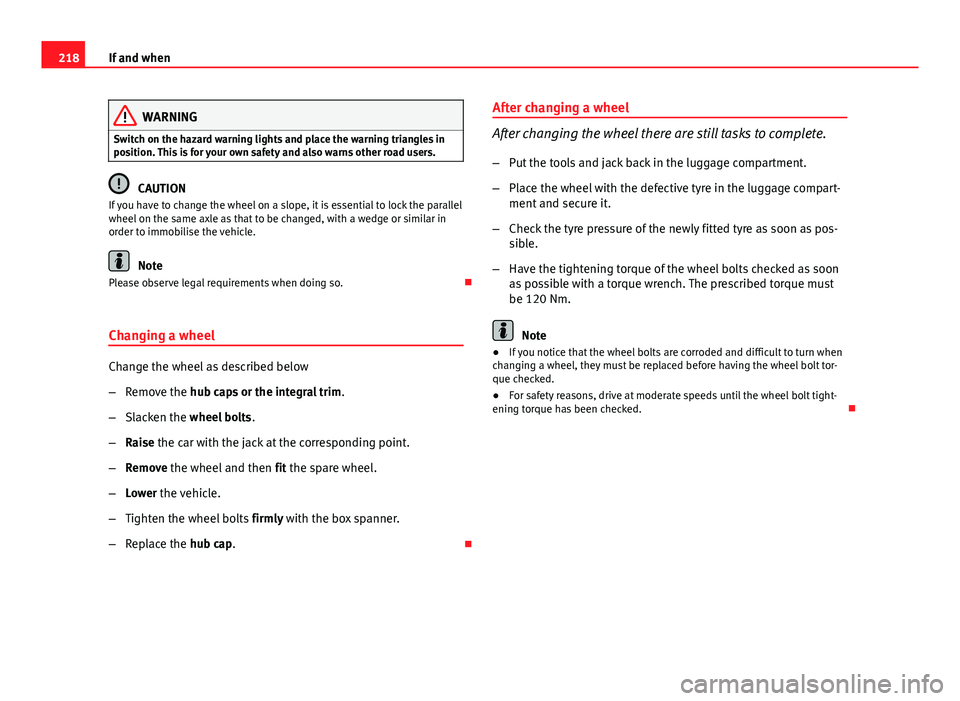
218If and when
WARNING
Switch on the hazard warning lights and place the warning triangles in
position. This is for your own safety and also warns other road users.
CAUTION
If you have to change the wheel on a slope, it is essential to lock the parallel
wheel on the same axle as that to be changed, with a wedge or similar in
order to immobilise the vehicle.
Note
Please observe legal requirements when doing so.
Changing a wheel
Change the wheel as described below
– Remove the hub caps or the integral trim .
– Slacken the wheel bolts .
– Raise the car with the jack at the corresponding point.
– Remove the wheel and then fit the spare wheel.
– Lower the vehicle.
– Tighten the wheel bolts firmly with the box spanner.
– Replace the hub cap. After changing a wheel
After changing the wheel there are still tasks to complete.
– Put the tools and jack back in the luggage compartment.
– Place the wheel with the defective tyre in the luggage compart-
ment and secure it.
– Check the tyre pressure of the newly fitted tyre as soon as pos-
sible.
– Have the tightening torque of the wheel bolts checked as soon
as possible with a torque wrench. The prescribed torque must
be 120 Nm.
Note
● If you notice that the wheel bolts are corroded and difficult to turn when
changing a wheel, they must be replaced before having the wheel bolt tor-
que checked.
● For safety reasons, drive at moderate speeds until the wheel bolt tight-
ening torque has been checked.
Page 251 of 278
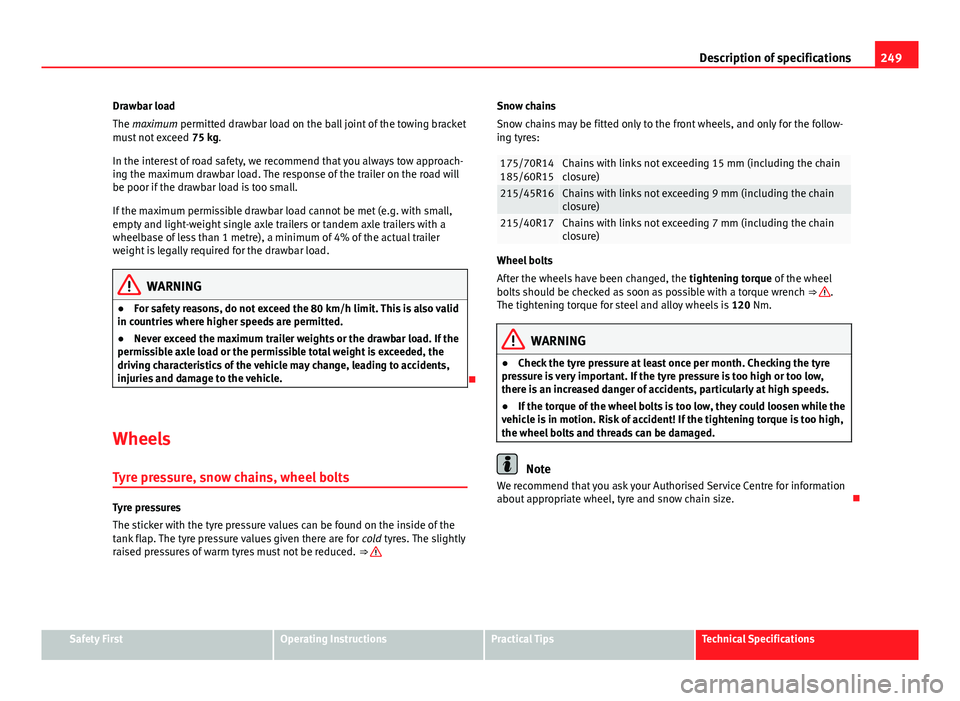
249
Description of specifications
Drawbar load
The maximum permitted drawbar load on the ball joint of the towing bracket
must not exceed 75 kg.
In the interest of road safety, we recommend that you always tow approach-
ing the maximum drawbar load. The response of the trailer on the road will
be poor if the drawbar load is too small.
If the maximum permissible drawbar load cannot be met (e.g. with small,
empty and light-weight single axle trailers or tandem axle trailers with a
wheelbase of less than 1 metre), a minimum of 4% of the actual trailer
weight is legally required for the drawbar load.
WARNING
● For safety reasons, do not exceed the 80 km/h limit. This is also valid
in countries where higher speeds are permitted.
● Never exceed the maximum trailer weights or the drawbar load. If the
permissible axle load or the permissible total weight is exceeded, the
driving characteristics of the vehicle may change, leading to accidents,
injuries and damage to the vehicle.
Wheels
Tyre pressure, snow chains, wheel bolts
Tyre pressures
The sticker with the tyre pressure values can be found on the inside of the
tank flap. The tyre pressure values given there are for cold tyres. The slightly
raised pressures of warm tyres must not be reduced. ⇒
Snow chains
Snow chains may be fitted only to the front wheels, and only for the follow-
ing tyres:
175/70R14
185/60R15Chains with links not exceeding 15 mm (including the chain
closure)
215/45R16Chains with links not exceeding 9 mm (including the chain
closure)
215/40R17Chains with links not exceeding 7 mm (including the chain
closure)
Wheel bolts
After the wheels have been changed, the tightening torque of the wheel
bolts should be checked as soon as possible with a torque wrench ⇒
.
The tightening torque for steel and alloy wheels is 120 Nm.
WARNING
● Check the tyre pressure at least once per month. Checking the tyre
pressure is very important. If the tyre pressure is too high or too low,
there is an increased danger of accidents, particularly at high speeds.
● If the torque of the wheel bolts is too low, they could loosen while the
vehicle is in motion. Risk of accident! If the tightening torque is too high,
the wheel bolts and threads can be damaged.
Note
We recommend that you ask your Authorised Service Centre for information
about appropriate wheel, tyre and snow chain size.
Safety FirstOperating InstructionsPractical TipsTechnical Specifications
Page 275 of 278
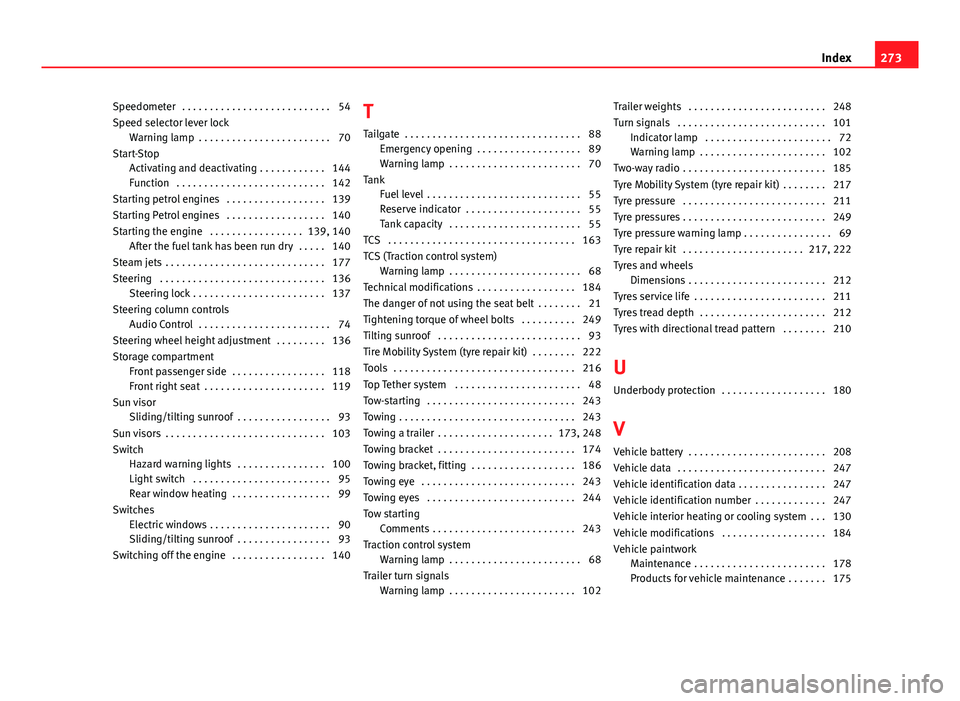
Speedometer . . . . . . . . . . . . . . . . . . . . . . . . . . . 54
Speed selector lever lockWarning lamp . . . . . . . . . . . . . . . . . . . . . . . . 70
Start-Stop Activating and deactivating . . . . . . . . . . . . 144
Function . . . . . . . . . . . . . . . . . . . . . . . . . . . 142
Starting petrol engines . . . . . . . . . . . . . . . . . . 139
Starting Petrol engines . . . . . . . . . . . . . . . . . . 140
Starting the engine . . . . . . . . . . . . . . . . . 139, 140 After the fuel tank has been run dry . . . . . 140
Steam jets . . . . . . . . . . . . . . . . . . . . . . . . . . . . . 177
Steering . . . . . . . . . . . . . . . . . . . . . . . . . . . . . . 136 Steering lock . . . . . . . . . . . . . . . . . . . . . . . . 137
Steering column controls Audio Control . . . . . . . . . . . . . . . . . . . . . . . . 74
Steering wheel height adjustment . . . . . . . . . 136
Storage compartment Front passenger side . . . . . . . . . . . . . . . . . 118
Front right seat . . . . . . . . . . . . . . . . . . . . . . 119
Sun visor Sliding/tilting sunroof . . . . . . . . . . . . . . . . . 93
Sun visors . . . . . . . . . . . . . . . . . . . . . . . . . . . . . 103
Switch Hazard warning lights . . . . . . . . . . . . . . . . 100
Light switch . . . . . . . . . . . . . . . . . . . . . . . . . 95
Rear window heating . . . . . . . . . . . . . . . . . . 99
Switches Electric windows . . . . . . . . . . . . . . . . . . . . . . 90
Sliding/tilting sunroof . . . . . . . . . . . . . . . . . 93
Switching off the engine . . . . . . . . . . . . . . . . . 140 T
Tailgate . . . . . . . . . . . . . . . . . . . . . . . . . . . . . . . . 88 Emergency opening . . . . . . . . . . . . . . . . . . . 89
Warning lamp . . . . . . . . . . . . . . . . . . . . . . . . 70
Tank Fuel level . . . . . . . . . . . . . . . . . . . . . . . . . . . . 55
Reserve indicator . . . . . . . . . . . . . . . . . . . . . 55
Tank capacity . . . . . . . . . . . . . . . . . . . . . . . . 55
TCS . . . . . . . . . . . . . . . . . . . . . . . . . . . . . . . . . . 163
TCS (Traction control system) Warning lamp . . . . . . . . . . . . . . . . . . . . . . . . 68
Technical modifications . . . . . . . . . . . . . . . . . . 184
The danger of not using the seat belt . . . . . . . . 21
Tightening torque of wheel bolts . . . . . . . . . . 249
Tilting sunroof . . . . . . . . . . . . . . . . . . . . . . . . . . 93
Tire Mobility System (tyre repair kit) . . . . . . . . 222
Tools . . . . . . . . . . . . . . . . . . . . . . . . . . . . . . . . . 216
Top Tether system . . . . . . . . . . . . . . . . . . . . . . . 48
Tow-starting . . . . . . . . . . . . . . . . . . . . . . . . . . . 243
Towing . . . . . . . . . . . . . . . . . . . . . . . . . . . . . . . . 243
Towing a trailer . . . . . . . . . . . . . . . . . . . . . 173, 248
Towing bracket . . . . . . . . . . . . . . . . . . . . . . . . . 174
Towing bracket, fitting . . . . . . . . . . . . . . . . . . . 186
Towing eye . . . . . . . . . . . . . . . . . . . . . . . . . . . . 243
Towing eyes . . . . . . . . . . . . . . . . . . . . . . . . . . . 244
Tow starting Comments . . . . . . . . . . . . . . . . . . . . . . . . . . 243
Traction control system Warning lamp . . . . . . . . . . . . . . . . . . . . . . . . 68
Trailer turn signals Warning lamp . . . . . . . . . . . . . . . . . . . . . . . 102 Trailer weights . . . . . . . . . . . . . . . . . . . . . . . . . 248
Turn signals . . . . . . . . . . . . . . . . . . . . . . . . . . . 101
Indicator lamp . . . . . . . . . . . . . . . . . . . . . . . 72
Warning lamp . . . . . . . . . . . . . . . . . . . . . . . 102
Two-way radio . . . . . . . . . . . . . . . . . . . . . . . . . . 185
Tyre Mobility System (tyre repair kit) . . . . . . . . 217
Tyre pressure . . . . . . . . . . . . . . . . . . . . . . . . . . 211
Tyre pressures . . . . . . . . . . . . . . . . . . . . . . . . . . 249
Tyre pressure warning lamp . . . . . . . . . . . . . . . . 69
Tyre repair kit . . . . . . . . . . . . . . . . . . . . . . 217, 222
Tyres and wheels Dimensions . . . . . . . . . . . . . . . . . . . . . . . . . 212
Tyres service life . . . . . . . . . . . . . . . . . . . . . . . . 211
Tyres tread depth . . . . . . . . . . . . . . . . . . . . . . . 212
Tyres with directional tread pattern . . . . . . . . 210
U
Underbody protection . . . . . . . . . . . . . . . . . . . 180
V
Vehicle battery . . . . . . . . . . . . . . . . . . . . . . . . . 208
Vehicle data . . . . . . . . . . . . . . . . . . . . . . . . . . . 247
Vehicle identification data . . . . . . . . . . . . . . . . 247
Vehicle identification number . . . . . . . . . . . . . 247
Vehicle interior heating or cooling system . . . 130
Vehicle modifications . . . . . . . . . . . . . . . . . . . 184
Vehicle paintwork Maintenance . . . . . . . . . . . . . . . . . . . . . . . . 178
Products for vehicle maintenance . . . . . . . 175
273
Index
Page 276 of 278
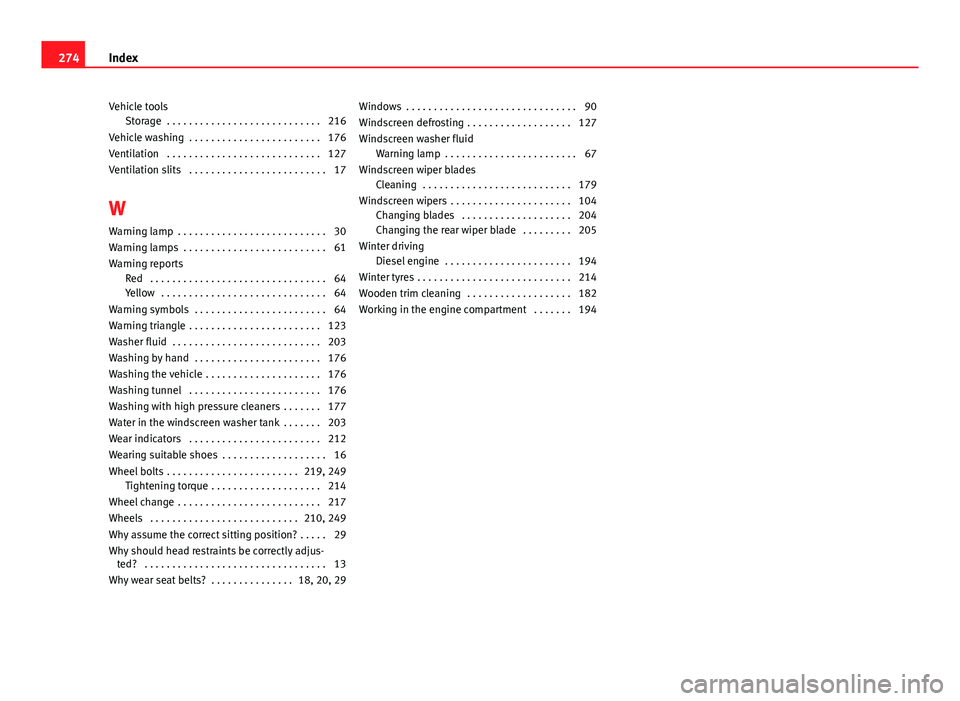
Vehicle toolsStorage . . . . . . . . . . . . . . . . . . . . . . . . . . . . 216
Vehicle washing . . . . . . . . . . . . . . . . . . . . . . . . 176
Ventilation . . . . . . . . . . . . . . . . . . . . . . . . . . . . 127
Ventilation slits . . . . . . . . . . . . . . . . . . . . . . . . . 17
W Warning lamp . . . . . . . . . . . . . . . . . . . . . . . . . . . 30
Warning lamps . . . . . . . . . . . . . . . . . . . . . . . . . . 61
Warning reports Red . . . . . . . . . . . . . . . . . . . . . . . . . . . . . . . . 64
Yellow . . . . . . . . . . . . . . . . . . . . . . . . . . . . . . 64
Warning symbols . . . . . . . . . . . . . . . . . . . . . . . . 64
Warning triangle . . . . . . . . . . . . . . . . . . . . . . . . 123
Washer fluid . . . . . . . . . . . . . . . . . . . . . . . . . . . 203
Washing by hand . . . . . . . . . . . . . . . . . . . . . . . 176
Washing the vehicle . . . . . . . . . . . . . . . . . . . . . 176
Washing tunnel . . . . . . . . . . . . . . . . . . . . . . . . 176
Washing with high pressure cleaners . . . . . . . 177
Water in the windscreen washer tank . . . . . . . 203
Wear indicators . . . . . . . . . . . . . . . . . . . . . . . . 212
Wearing suitable shoes . . . . . . . . . . . . . . . . . . . 16
Wheel bolts . . . . . . . . . . . . . . . . . . . . . . . . 219, 249 Tightening torque . . . . . . . . . . . . . . . . . . . . 214
Wheel change . . . . . . . . . . . . . . . . . . . . . . . . . . 217
Wheels . . . . . . . . . . . . . . . . . . . . . . . . . . . 210, 249
Why assume the correct sitting position? . . . . . 29
Why should head restraints be correctly adjus- ted? . . . . . . . . . . . . . . . . . . . . . . . . . . . . . . . . . 13
Why wear seat belts? . . . . . . . . . . . . . . . 18, 20, 29 Windows . . . . . . . . . . . . . . . . . . . . . . . . . . . . . . . 90
Windscreen defrosting . . . . . . . . . . . . . . . . . . . 127
Windscreen washer fluid
Warning lamp . . . . . . . . . . . . . . . . . . . . . . . . 67
Windscreen wiper blades Cleaning . . . . . . . . . . . . . . . . . . . . . . . . . . . 179
Windscreen wipers . . . . . . . . . . . . . . . . . . . . . . 104 Changing blades . . . . . . . . . . . . . . . . . . . . 204
Changing the rear wiper blade . . . . . . . . . 205
Winter driving Diesel engine . . . . . . . . . . . . . . . . . . . . . . . 194
Winter tyres . . . . . . . . . . . . . . . . . . . . . . . . . . . . 214
Wooden trim cleaning . . . . . . . . . . . . . . . . . . . 182
Working in the engine compartment . . . . . . . 194
274 Index